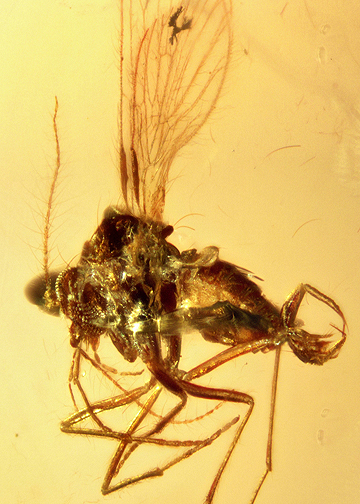Abstract
Paleopsychoda jarzembowskii sp. nov. is characterized, illustrated, and described from the lower Barremian amber of Mdeyrij-Hammana (Lebanon). It represents the first psychodid fly in Lower Cretaceous amber showing sexual dimorphism in wing characters. The discovery of this Cretaceous psychodid fly demonstrates that this genus had a large diversification and broad distribution, and improves our knowledge of the evolution of moth flies.
References
- Azar, D., Adaymeh, C. & Jreich, N. (2007) Paleopsychoda zherikhini, a new Cretaceous species of moth flies from Taimyr amber (Diptera: Psychodidae: Psychodinae). African Invertebrates, 48 (1), 163–168.
- Azar, D. & Maksoud, S. (2020) A new species of Protopsychoda Azar et al., 1999 from the Lower Cretaceous Lebanese amber (Diptera: Psychodidae). Palaeoentomology, 3 (4), 352–356. https://doi.org/10.11646/palaeoentomology.3.4.5
- Azar, D., Nel, A., Solignac, M., Paicheler, J.-C. & Bouchet, F. (1999) New genera and species of psychodoid flies from the Lower Cretaceous amber of Lebanon. Palaeontology, 42 (6), 1101–1136. https://doi.org/10.1111/1475-4983.00112
- Azar, D., Perrichot, V., Néraudeau, D. & Nel, A. (2003) New psychodids from the Cretaceous ambers of Lebanon and France, with a discussion of Eophlebotomus connectens Cockerell, 1920 (Diptera, Psychodidae). Annals of the Entomological Society of America, 96 (2), 117‒126. https://doi.org/10.1603/0013-8746(2003)096[0117:NPFTCA]2.0.CO;2
- Byers, G.W. (1989) Homologies in wing venation of primitive Diptera and Mecoptera. Proceedings of the Entomological Society of Washington, 91, 497–501.
- Curler, G.R. & Moulton, J.K. (2012) Phylogeny of psychodid subfamilies (Diptera: Psychodidae) inferred from nuclear DNA sequences with a review of morphological evidence for relationships. Systematic Entomology, 37, 603–616. https://doi.org/10.1111/j.1365-3113.2012.00634.x
- Duckhouse, D.A. (1966) Psychodidae (Diptera, Nematocera) of Southern Australia: subfamily Psychodinae. Transaction of the Royal Entomological Society of London, 118, 153–220. https://doi.org/10.1111/j.1365-2311.1966.tb00837.x
- Granier, B., Toland, C., Gèze, R., Azar, D. & Maksoud, S. (2016) Some steps toward a new story for the Jurassic—Cretaceous transition in Mount Lebanon. Carnets de Géologie, 16, 247–269. https://doi.org/10.4267/2042/59924
- Hennig, W. (1972) Insektenfossilien aus der unteren Kreide. IV. Psychodidae (Phlebotominae), mit einer kritischen Übersicht über das phylogenetische System der Familie und die bisher beschriebenen Fossilien (Diptera). Stuttgarter Beiträge zur Naturkunde, Reihe B, 241, 1–69.
- Krzemiński, W. & Krzemińska, E. (2003) Triassic Diptera: Descriptions, revisions and phylogenetic relations. Acta Zoologica Cracoviensia, 46, 153–184.
- Kvifte, G.M. & Wagner, R. (2017) Psychodidae (sand flies, moth flies or owl flies). In: Kirk-Spriggs, A.H. & Sinclair, B.J. (Eds), Manual of Afrotropical Diptera. Volume 2. Nematocerous Diptera and lower Brachycera. Suricata 5. South African National Biodiversity Institute, Pretoria, pp. 607–632.
- Maksoud, S. & Azar, D. (2020) Lebanese amber: latest updates. Palaeoentomology, 3 (2), 125–155. https://doi.org/10.11646/palaeoentomology.3.2.2
- Maksoud, S., Azar, D, Granier, B. & Gèze, R. (2017) New data on the age of the Lower Cretaceous amber outcrops of Lebanon. Palaeoworld, 26 (2), 331–338. https://doi.org/10.1016/j.palwor.2016.03.003
- McAlpine, J.F. (1981) Morphology and terminology—adults. In: McAlpine, J.F., Peterson, B.V., Shewell, G.E., Teskey, H.J., Vockeroth, J.R. & Wood, D.M. (coordinators), Manual of Nearctic Diptera. Volume 1. Research Branch, Agriculture Canada, Monograph No. 27, Ottawa, pp. 9‒63.
- Williams, P. (1993) Relationships of phlebotomine sand flies (Diptera). Memórias do Instituto Oswaldo Cruz, 88, 177–183. https://doi.org/10.1590/S0074-02761993000200001


